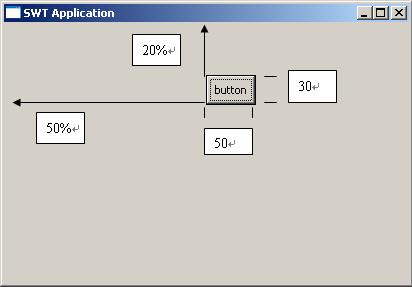自定义布局管理器-FormLayout
第二部分:自定义布局管理器
在java.awt包与javax.swing包下有许多现成的布局类,比如BorderLayout、FlowLayout,还有较为复杂的、用于精确定位的布局类GridBagLayout、SpringLayout等。起初我刚刚从事gooey时(06年中),企图依靠JDK自带的布局类进行布局,但是实际不可能或者说很难做到。对于复杂的GridBagLayout、SpringLayout来说又望而生畏,而且使用GridBagLayout、SpringLayout来完成布局的话工作量相当可观,因此当时放弃了布局管理器,采用ComponentListener等尺寸监听事件来布局组件。虽然这种做法没有工具支持、采用手工coding,但是自由度上升了很多,而且熟悉了以后编码效率也大幅其高。与此同时,我开始接触SWT,发现org.eclipse.swt.layout.FormLayout布局很强大、用起来爱不释手、要多好有多好、要多强有多强......。于是当时我用来布局组件的方式是采用ComponentListener监听与FormLayout结合的方式,也是在同期,我领悟到了九宫图这种专业布局,因此之后九宫图的实现也都采用上述两种方法。随着对SWT的不断了解外加IM软件界面的专业性,我发现SWT并不非常适合做专业外观,也因为此我逐渐将精力转向Swing。
在介绍如何编写自定义布局管理器前,我想先把SWT体系下的FormLayout布局(表单布局)特点做个简要介绍。
SWT体系下的FormLayout是非常灵活、精确的布局,FormLayout布局组件的特点是采用百分比+偏移量的方式。前者可以应付容器尺寸变化时内部组件随之等比例调整;后者以应付精确的布局。这一特征是通过org.eclipse.swt.layout.FormData和org.eclipse.swt.layout.FormAttachment两个类来实现。
通常使用FormLayout来定位一个组件要确定4个FormAttachment对象:top、bottom、left、right,即组件的4条边。而且通常是使用FormAttachment(int numerator,int offset)这个构造器,也就是百分比+偏移量。当然FormAttachment不只这一种,但是都是可选的,如果想深入研究FormLayout可以参阅SWT相关的介绍。
下面给出一段SWT示例程序:
运行效果如下:

由运行效果可以看出,FormLayout通过指定组件的四条边来完成布局。
FormLayout很强大、灵活,但是AWT、Swing包中却没有,但是不等于说不能实现,学习了上文之后当然可以移植到Swing中来。
SWT中使用FormLayout还要结合FormData(表单数据)与FormAttachment(表单附件)。下面给出这两个移植过来的类实现
你应该了解坐标系的概念,Java中的坐标系以向右、向下为正方向。因此对于offset,正值是向右、向下偏移;负值是向左、向上偏移。
在FormLayout布局中,定位一个组件需要最多4个FormAttachment对象,但是可以不必全部指定,稍后可以看到缺省的行为。
如果你的布局管理器比较简单,可以实现LayoutManager接口。但是正如上文所述,LayoutManager的addLayoutComponent(String name, Component comp)方法是必须通过java.awt.Container类的“Component add(String name, Component comp)”方法触发调用,其中的字符串参数指定了布局信息。但是字符串表达方式很有限,因此应当采用LayoutManager2接口,这样,addLayoutComponent(Component comp, Object constraints)方法被调用时,“Object constraints”可以是任何类型的对象,很方便。下面逐步实现这个类。
首先搭建的原型如下
public final class FormLayout implements LayoutManager2 {
public void addLayoutComponent(Component comp, Object constraints) {}
public float getLayoutAlignmentX(Container target) {
return 0;
}
public float getLayoutAlignmentY(Container target) {
return 0;
}
public void invalidateLayout(Container target) {}
public Dimension maximumLayoutSize(Container target) {
return null;
}
public void addLayoutComponent(String name, Component comp) {}
public void layoutContainer(Container parent) {}
public Dimension minimumLayoutSize(Container parent) {
return null;
}
public Dimension preferredLayoutSize(Container parent) {
return null;
}
public void removeLayoutComponent(Component comp) {}
}
再声明一个保存组件与布局信息对应关系的映射:private final Map<Component, FormData> componentConstraints = new HashMap<Component, FormData>();
getContentPane().setLayout(new FormLayout());
JButton button = new JButton();
button.setText("button");
FormData formData = new FormData();
formData.top = new FormAttachment(0.2f, 0);
formData.left = new FormAttachment(0.5f, 0);
formData.bottom = new FormAttachment(0.2f, 30);
formData.right = new FormAttachment(0.5f, 50);
getContentPane().add(button,formData);
如上所示,当调用“getContentPane().add(button,formData);”时,布局类的 public void addLayoutComponent(Component comp, Object constraints)方法便会调用,constraints参数就是FormData对象。所以在addLayoutComponent方法中需要做的就是把组件与布局信息关联起来。下面是完整实现:
}
对于addLayoutComponent(String name, Component comp)方法,由于通过查看源码发现“实现了LayoutManager2 接口的布局类该方法永远不会被调用”(未来的JDK版本如何实现不能保证),所以该方法空实现,并在注视上作@deprecated标记。
/**
* @deprecated
*/
public void addLayoutComponent(String name, Component comp) {}
除了layoutContainer方法,其余方法均很简单。一并给出:
public float getLayoutAlignmentX(Container target) {
return 0.5f;
}
public float getLayoutAlignmentY(Container target) {
return 0.5f;
}
public void invalidateLayout(Container target) {}
public Dimension maximumLayoutSize(Container target) {
return new Dimension(Integer.MAX_VALUE, Integer.MAX_VALUE);
}
public Dimension minimumLayoutSize(Container target) {
return new Dimension(0, 0);
}
public Dimension preferredLayoutSize(Container target) {
return new Dimension(0, 0);
}
public void removeLayoutComponent(Component comp) {
synchronized (comp.getTreeLock()) {
componentConstraints.remove(comp);
}
}
根据上文所述,这些方法不难理解。其实对于FormLayout来说,...LayoutSize(Container target)、getLayoutAlignmentX等方法不是很重要。重要的是public void layoutContainer(Container target)的实现,也是所有布局类最重要的一个类。
首先该方法的第一步也要套上 synchronized (target.getTreeLock()) {},所有的代码放入同步块中。接下来是:
final FormData formData = componentConstraints.get(comp);
if (formData == null) {
continue;
}
因为在addLayoutComponent(Component comp, Object constraints)方法中已经关联了组件与布局信息,所以可以通过componentMap.get(comp)这一行得到组件的布局信息,加上空值判断确保代码万无一失。
接下来取出4个FormAttachment对象,表示组件的四条边。
然后计算Location信息(组件左上角的坐标)x、y:
然后计算组件的长、高,width、height:
计算时根据给出right与bottom布局分为两种情况,如果未给出,那么根据组件的getPreferredSize方法得到组件的最佳大小,以这个大小决定组件的尺寸。作为规范,使用布局管理器布局不是参照组件的getSize而是参照getPreferredSize来最终决定组件的尺寸,所有布局管理器也都是这么实现的。所以如果你企图
设置组件的setSize()方法来达到在布局管理器中布局的目的是不可能的,所以你应该视图调用组件的setPreferredSize方法。接上,如果right和bottom都不是null,那么计算组件尺寸将忽略getPreferredSize,计算x2和y2的坐标,然后两坐标相减得到长宽。最后调用组件的setBounds进行最终定位。
作为FormLayout需要补充的是,在进行最终布局“component.setBounds(x, y, width, height);”之前,未进行逻辑判断,所以x、y可能会超出了容器的范围而width、height也可能是负值,这都会导致组件“莫名其妙”地不可见,这都不是布局管理器的问题。例如以下两行代码:
formData.left = new FormAttachment(0.5f, 30);
formData.right = new FormAttachment(0.5f, 20);
就会使组件永远不能显示,因为对于left的定位,是位于容器50%处向右30像素处,而right是位于容器50%处向右20像素处,这样组件的长度就是-10,怎么能显示出来呢?
本文转自:http://www.blogjava.net/javagui/archive/2007/11/24/FormLayout.html